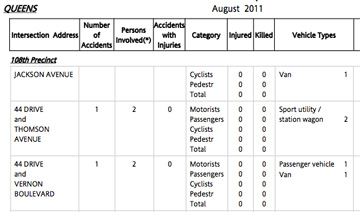When the City Council passed Jessica Lappin's Saving Lives Through Better Information bill last year, traffic safety and open government advocates cheered. Under the law, the NYPD is required to provide monthly data on both traffic crashes and traffic summonsing, shedding light on the hazards of city streets and what steps police take to protect New Yorkers from dangerous drivers.
The information the NYPD finally provided under that law turned out to be informative -- showing, for example, that the police hand out more than twice as many tickets for seat belt violations than for speeding -- but formatted in a clunky way almost guaranteed to stymie people looking to analyze the data systematically. The data is released as PDF files: not mappable, not sortable, and not even easy to search.
New Yorkers may finally be getting access to the high-quality traffic data they are entitled to, however, thanks to a wide-ranging open data law passed by the City Council. In general, any data that could be obtained under a Freedom of Information Law request would be proactively released under the new policy, according to the Gotham Gazette.
In announcing the passage of the open data law, City Council Speaker Christine Quinn specifically highlighted the need for better traffic data. "While we can currently get this data, it is not in an open format," Quinn said in a press release. "It cannot be sorted by community board, by frequency of accidents or by contributing factor. Being able to analyze this information will help us to better target safety efforts, utilize resources and save lives.”
At the press conference announcing the bill's passage, Quinn specifically cited her inability to see where crashes had taken place on Ninth Avenue in her district using the NYPD's current data.






